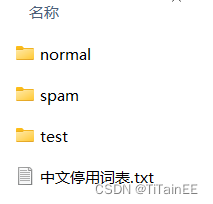朴素贝叶斯法概念
朴素贝叶斯法是基于贝叶斯定理与特征条件独立假设的分类方法。
最为广泛的两种分类模型是决策树模型(Decision Tree Model)和朴素贝叶斯模型(Naive Bayesian Model,NBM)。和决策树模型相比,朴素贝叶斯分类器(Naive Bayes Classifier 或 NBC)发源于古典数学理论,有着坚实的数学基础,以及稳定的分类效率。同时,NBC模型所需估计的参数很少,对缺失数据不太敏感,算法也比较简单。理论上,NBC模型与其他分类方法相比具有最小的误差率。但是实际上并非总是如此,这是因为NBC模型假设属性之间相互独立,这个假设在实际应用中往往是不成立的,这给NBC模型的正确分类带来了一定影响。
贝叶斯定理
先验概率:即基于统计的概率,是基于以往历史经验和分析得到的结果,不需要依赖当前发生的条件。
后验概率:则是从条件概率而来,由因推果,是基于当下发生了事件之后计算的概率,依赖于当前发生的条件。
条件概率:记事件A发生的概率为P(A),事件B发生的概率为P(B),则在B事件发生的前提下,A事件发生的概率即为条件概率,记为P(A|B)。
P
(
A
∣
B
)
=
P
(
A
B
)
P
(
B
)
P(A|B)=\frac{P(AB)}{P(B)}
P(A∣B)=P(B)P(AB)
贝叶斯公式:贝叶斯公式便是基于条件概率,通过P(B|A)来求P(A|B),如下:
P
(
A
)
=
P
(
A
∣
B
)
×
P
(
B
)
P
(
B
∣
A
)
P(A)=\frac{P(A|B)\times P(B)}{P(B|A)}
P(A)=P(B∣A)P(A∣B)×P(B)
全概率公式:表示若事件{A_1},{A_2}, \cdots ,{A_n}构成一个完备事件组且都有正概率,则对任意一个事件B都有公式成立:
P
(
B
)
=
∑
i
=
1
n
P
(
B
∣
A
i
)
×
P
(
A
i
)
P(B)=\sum_{i=1}^{n} P\left(B \mid A_{i}\right) \times P\left(A_{i}\right)
P(B)=i=1∑nP(B∣Ai)×P(Ai)
将全概率公式带入贝叶斯公式中,得到:
P
(
A
)
=
P
(
A
∣
B
)
×
P
(
B
)
P
(
B
∣
A
)
=
P
(
A
∣
B
)
×
∏
i
=
0
N
P
(
B
i
)
P
(
B
∣
A
)
P(A)=\frac{P(A|B)\times P(B)}{P(B|A)} =\frac{P(A|B)\times \prod_{i=0}^{N}P(B_i)}{P(B|A)}
P(A)=P(B∣A)P(A∣B)×P(B)=P(B∣A)P(A∣B)×∏i=0NP(Bi)
朴素贝叶斯算法的优缺点
优点:
1.朴素贝叶斯模型有稳定的分类效率。
2.对小规模的数据表现很好,能处理多分类任务,适合增量式训练,尤其是数据量超出内存时,可以一批批的去增量训练。
3.对缺失数据不太敏感,算法也比较简单,常用于文本分类。
缺点:
1.需要知道先验概率,且先验概率很多时候取决于假设,假设的模型可以有很多种,因此在某些时候会由于假设的先验模型的原因导致预测效果不佳。
2.由于通过先验和数据来决定后验的概率从而决定分类,所以分类决策存在一定的错误率。
实现垃圾邮件分类
数据集

代码实现
读取数据集
#获得停用词表
def getStopWords(self):
stopList=[]
for line in open("data\中文停用词表.txt"):
stopList.append(line[:len(line)-1])
return stopList;
#获得词典
def get_word_list(self,content,wordsList,stopList):
#分词结果放入res_list
res_list = list(jieba.cut(content))
for i in res_list:
if i not in stopList and i.strip()!='' and i!=None:
if i not in wordsList:
wordsList.append(i)
计算15个影响最大的词
#通过计算每个文件中p(s|w)来得到对分类影响最大的15个词
def getTestWords(self,testDict,spamDict,normDict,normFilelen,spamFilelen):
wordProbList={}
for word,num in testDict.items():
if word in spamDict.keys() and word in normDict.keys():
#该文件中包含词个数
pw_s=spamDict[word]/spamFilelen
pw_n=normDict[word]/normFilelen
ps_w=pw_s/(pw_s+pw_n)
wordProbList.setdefault(word,ps_w)
if word in spamDict.keys() and word not in normDict.keys():
pw_s=spamDict[word]/spamFilelen
pw_n=0.01
ps_w=pw_s/(pw_s+pw_n)
wordProbList.setdefault(word,ps_w)
if word not in spamDict.keys() and word in normDict.keys():
pw_s=0.01
pw_n=normDict[word]/normFilelen
ps_w=pw_s/(pw_s+pw_n)
wordProbList.setdefault(word,ps_w)
if word not in spamDict.keys() and word not in normDict.keys():
#若该词不在脏词词典中,概率设为0.4
wordProbList.setdefault(word,0.4)
sorted(wordProbList.items(),key=lambda d:d[1],reverse=True)[0:15]
return (wordProbList)
计算贝叶斯概率
#计算贝叶斯概率
def calBayes(self,wordList,spamdict,normdict):
ps_w=1
ps_n=1
for word,prob in wordList.items() :
print(word+"/"+str(prob))
ps_w*=(prob)
ps_n*=(1-prob)
p=ps_w/(ps_w+ps_n)
# print(str(ps_w)+"////"+str(ps_n))
return p
垃圾邮件贝叶斯
import jieba;
import os;
class spamEmailBayes:
#获得停用词表
def getStopWords(self):
stopList=[]
for line in open("data\中文停用词表.txt"):
stopList.append(line[:len(line)-1])
return stopList;
#获得词典
def get_word_list(self,content,wordsList,stopList):
#分词结果放入res_list
res_list = list(jieba.cut(content))
for i in res_list:
if i not in stopList and i.strip()!='' and i!=None:
if i not in wordsList:
wordsList.append(i)
#若列表中的词已在词典中,则加1,否则添加进去
def addToDict(self,wordsList,wordsDict):
for item in wordsList:
if item in wordsDict.keys():
wordsDict[item]+=1
else:
wordsDict.setdefault(item,1)
def get_File_List(self,filePath):
filenames=os.listdir(filePath)
return filenames
#通过计算每个文件中p(s|w)来得到对分类影响最大的15个词
def getTestWords(self,testDict,spamDict,normDict,normFilelen,spamFilelen):
wordProbList={}
for word,num in testDict.items():
if word in spamDict.keys() and word in normDict.keys():
#该文件中包含词个数
pw_s=spamDict[word]/spamFilelen
pw_n=normDict[word]/normFilelen
ps_w=pw_s/(pw_s+pw_n)
wordProbList.setdefault(word,ps_w)
if word in spamDict.keys() and word not in normDict.keys():
pw_s=spamDict[word]/spamFilelen
pw_n=0.01
ps_w=pw_s/(pw_s+pw_n)
wordProbList.setdefault(word,ps_w)
if word not in spamDict.keys() and word in normDict.keys():
pw_s=0.01
pw_n=normDict[word]/normFilelen
ps_w=pw_s/(pw_s+pw_n)
wordProbList.setdefault(word,ps_w)
if word not in spamDict.keys() and word not in normDict.keys():
#若该词不在脏词词典中,概率设为0.4
wordProbList.setdefault(word,0.4)
sorted(wordProbList.items(),key=lambda d:d[1],reverse=True)[0:15]
return (wordProbList)
#计算贝叶斯概率
def calBayes(self,wordList,spamdict,normdict):
ps_w=1
ps_n=1
for word,prob in wordList.items() :
print(word+"/"+str(prob))
ps_w*=(prob)
ps_n*=(1-prob)
p=ps_w/(ps_w+ps_n)
# print(str(ps_w)+"////"+str(ps_n))
return p
#计算预测结果正确率
def calAccuracy(self,testResult):
rightCount=0
errorCount=0
for name ,catagory in testResult.items():
if (int(name)<1000 and catagory==0) or(int(name)>1000 and catagory==1):
rightCount+=1
else:
errorCount+=1
return rightCount/(rightCount+errorCount)
预测实现
from spam.spamEmail import spamEmailBayes
import re
#spam类对象
spam=spamEmailBayes()
#保存词频的词典
spamDict={}
normDict={}
testDict={}
#保存每封邮件中出现的词
wordsList=[]
wordsDict={}
#保存预测结果,key为文件名,值为预测类别
testResult={}
#分别获得正常邮件、垃圾邮件及测试文件名称列表
normFileList=spam.get_File_List(r"data\normal")
spamFileList=spam.get_File_List(r"data\spam")
testFileList=spam.get_File_List(r"data\test")
#获取训练集中正常邮件与垃圾邮件的数量
normFilelen=len(normFileList)
spamFilelen=len(spamFileList)
#获得停用词表,用于对停用词过滤
stopList=spam.getStopWords()
#获得正常邮件中的词频
for fileName in normFileList:
wordsList.clear()
for line in open("data/normal/"+fileName):
#过滤掉非中文字符
rule=re.compile(r"[^\u4e00-\u9fa5]")
line=rule.sub("",line)
#将每封邮件出现的词保存在wordsList中
spam.get_word_list(line,wordsList,stopList)
#统计每个词在所有邮件中出现的次数
spam.addToDict(wordsList, wordsDict)
normDict=wordsDict.copy()
#获得垃圾邮件中的词频
wordsDict.clear()
for fileName in spamFileList:
wordsList.clear()
for line in open("data/spam/"+fileName):
rule=re.compile(r"[^\u4e00-\u9fa5]")
line=rule.sub("",line)
spam.get_word_list(line,wordsList,stopList)
spam.addToDict(wordsList, wordsDict)
spamDict=wordsDict.copy()
# 测试邮件
for fileName in testFileList:
testDict.clear( )
wordsDict.clear()
wordsList.clear()
for line in open("data/test/"+fileName):
rule=re.compile(r"[^\u4e00-\u9fa5]")
line=rule.sub("",line)
spam.get_word_list(line,wordsList,stopList)
spam.addToDict(wordsList, wordsDict)
testDict=wordsDict.copy()
#通过计算每个文件中p(s|w)来得到对分类影响最大的15个词
wordProbList=spam.getTestWords(testDict, spamDict,normDict,normFilelen,spamFilelen)
#对每封邮件得到的15个词计算贝叶斯概率
p=spam.calBayes(wordProbList, spamDict, normDict)
if(p>0.9):
testResult.setdefault(fileName,1)
else:
testResult.setdefault(fileName,0)
#计算分类准确率(测试集中文件名低于1000的为正常邮件)
testAccuracy=spam.calAccuracy(testResult)
for i,ic in testResult.items():
print(i+"/"+str(ic))
print(testAccuracy)
结果展示
使用朴素贝叶斯分类达到了95%的分类精度。

总结
朴素贝叶斯算法在处理垃圾邮件数据较少的情况下仍然有效,可以处理多类别问题,但是对于输入数据的准备方式较为敏感




 文章介绍了朴素贝叶斯法的概念,包括其基于贝叶斯定理和特征条件独立假设。通过Python代码展示了如何实现垃圾邮件分类,计算影响最大的词并计算贝叶斯概率。虽然朴素贝叶斯模型有参数少、对缺失数据不敏感等优点,但也存在假设属性独立的问题。最后,文章提到在数据集上实现了95%的分类精度,证明了朴素贝叶斯在小数据量时的有效性。
文章介绍了朴素贝叶斯法的概念,包括其基于贝叶斯定理和特征条件独立假设。通过Python代码展示了如何实现垃圾邮件分类,计算影响最大的词并计算贝叶斯概率。虽然朴素贝叶斯模型有参数少、对缺失数据不敏感等优点,但也存在假设属性独立的问题。最后,文章提到在数据集上实现了95%的分类精度,证明了朴素贝叶斯在小数据量时的有效性。
















 2673
2673

 被折叠的 条评论
为什么被折叠?
被折叠的 条评论
为什么被折叠?








